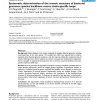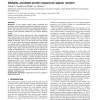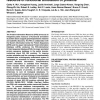281 search results - page 6 / 57 » Functional annotation of proteomic sequences based on consen... |
BMCBI
2005
13 years 7 months ago
2005
Background: Public databases now contain multitude of complete bacterial genomes, including several genomes of the same species. The available data offers new opportunities to add...
NAR
2011
12 years 10 months ago
2011
The primary purpose of PHOSIDA (http://www .phosida.com) is to manage posttranslational modification sites of various species ranging from bacteria to human. Since its last report...
NAR
2011
12 years 10 months ago
2011
The molecular diversity of viruses complicates the interpretation of viral genomic and proteomic data. To make sense of viral gene functions, investigators must be familiar with t...
BIOINFORMATICS
2010
13 years 7 months ago
2010
Motivation: To test whether protein folding constraints and secondary structure sequence preferences significantly reduce the space of amino acid words in proteins, we compared th...
NAR
2002
2002
The Protein Information Resource: an integrated public resource of functional annotation of proteins
13 years 7 months ago
The Protein Information Resource (PIR) serves as an integrated public resource of functional annotation of protein data to support genomic/proteomic research and scientific discov...



